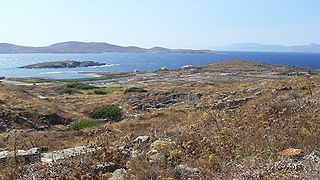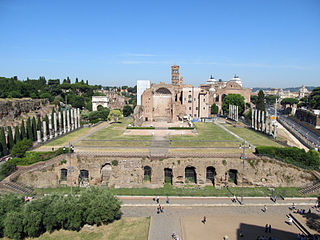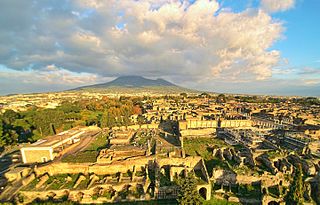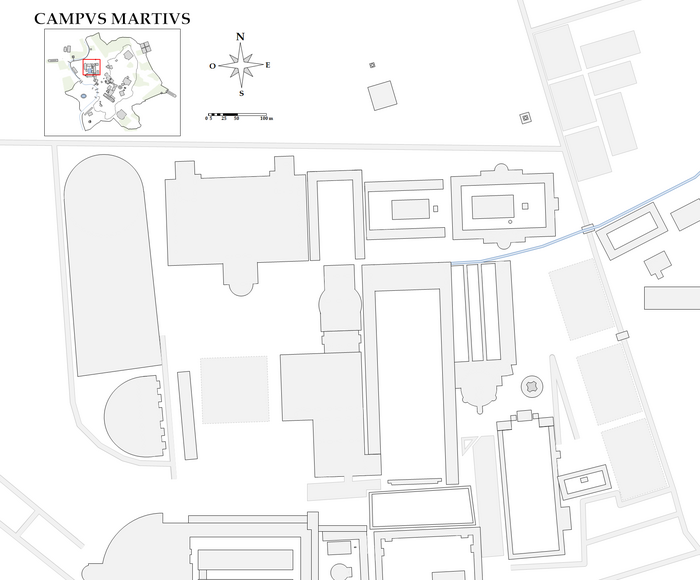
Delos, is a small Greek island near Mykonos, close to the centre of the Cyclades archipelago. Though only 3.43 km2 (1.32 sq mi) in area, it is one of the most important mythological, historical, and archaeological sites in Greece. The ongoing excavations in the island are among the most extensive in the Mediterranean, and many of the artifacts found are displayed at the Archaeological Museum of Delos and the National Archaeological Museum of Athens.

Grannus was a Celtic deity of classical antiquity. He was regularly identified with Apollo as Apollo Grannus and frequently worshipped in conjunction with Sirona, and sometimes with Mars and other deities.

The Campus Martius was a publicly owned area of ancient Rome about 2 square kilometres in extent. In the Middle Ages, it was the most populous area of Rome. The IV rione of Rome, Campo Marzio, which covers a smaller section of the original area, bears the same name.

Roman Egypt was an imperial province of the Roman Empire from 30 BC to AD 641. The province encompassed most of modern-day Egypt except for the Sinai. It was bordered by the provinces of Crete and Cyrenaica to the west and Judaea, later Arabia Petraea, to the East.

A serapeum is a temple or other religious institution dedicated to the syncretic Greco-Egyptian deity Serapis, who combined aspects of Osiris and Apis in a humanized form that was accepted by the Ptolemaic Greeks of Alexandria. There were several such religious centers, each of which was called a serapeion/serapeum or poserapi, coming from an Egyptian name for the temple of Osiris-Apis.

Santa Maria sopra Minerva is one of the major churches of the Order of Preachers in Rome, Italy. The church's name derives from the fact that the first Christian church structure on the site was built directly over the ruins or foundations of a temple dedicated to the Egyptian goddess Isis, which had been erroneously ascribed to the Greco-Roman goddess Minerva.

The Luxor Temple is a large Ancient Egyptian temple complex located on the east bank of the Nile River in the city today known as Luxor and was constructed approximately 1400 BCE. In the Egyptian language it was known as ipet resyt, "the southern sanctuary". It was one of the two primary temples on the east bank, the other being Karnak. Unlike the other temples in Thebes, Luxor temple is not dedicated to a cult god or a deified version of the pharaoh in death. Instead, Luxor temple is dedicated to the rejuvenation of kingship; it may have been where many of the pharaohs of Egypt were crowned in reality or conceptually.
The Temple of Isis, also known as an Iseum or Iseion, may refer to:

The Temple of Venus and Roma is thought to have been the largest temple in Ancient Rome. Located on the Velian Hill, between the eastern edge of the Forum Romanum and the Colosseum, it was dedicated to the goddesses Venus Felix and Roma Aeterna.

The Porticus Octaviae is an ancient structure in Rome. The colonnaded walks of the portico enclosed the Temples of Juno Regina (north) and Jupiter Stator (south), as well as a library. The structure was used as a fish market from the medieval period up to the end of the 19th century.

Serapis or Sarapis is a Graeco-Egyptian god. A syncretic deity derived from the worship of the Egyptian Osiris and Apis, Serapis was extensively popularized in the third century BC on the orders of Greek Pharaoh Ptolemy I Soter, as a means to unify the Greek and Egyptian subjects of the Ptolemaic Kingdom.

The Arch of Augustus was the triumphal arch of Augustus, located in the Roman Forum. It spanned the Via Sacra, between the Temple of Castor and Pollux and the Temple of Caesar, near the Temple of Vesta, closing off the eastern end of the Forum. It can be regarded as the first permanent three-bayed arch ever built in Rome.

The concept of Hellenistic religion as the late form of Ancient Greek religion covers any of the various systems of beliefs and practices of the people who lived under the influence of ancient Greek culture during the Hellenistic period and the Roman Empire. There was much continuity in Hellenistic religion: people continued to worship the Greek gods and to practice the same rites as in Classical Greece.

Santo Stefano de Pinea or more commonly Santo Stefano del Cacco is a church in Rome dedicated to Saint Stephen, located at Via di Santo Stefano del Cacco 26.

The Obelisk of Montecitorio, also known as Solare, is an ancient Egyptian, red granite obelisk of Psamtik II from Heliopolis. Brought to Rome with the Flaminio Obelisk in 10 BC by the Roman Emperor Augustus to be used as the gnomon of the Solarium Augusti, it is now in the Piazza Montecitorio. It is 21.79 metres (71 ft) high, and 33.97 metres (111 ft) including the base and the globe.

The Piazza della Rotonda is a piazza in Rome, Italy, on the south side of which is located the Pantheon. The square gets its name from the Pantheon's informal title as the church of Santa Maria Rotonda.

The Temple of Asclepius was an ancient Roman temple to Asclepius, the Greek god of medicine, on the Isola Tiberina in Rome.
The Temple of Minerva Chalcidica or Minervium was a small temple in the Campus Martius in ancient Rome, dedicated to Minerva. It was built by Pompey the Great in around 60 BC and probably destroyed in the fire of 80 AD which destroyed the Campus Martius. It was then rebuilt by Domitian.

The Temple of Serapis on the Quirinal Hill in Rome was an sanctuary in Ancient Rome dedicated to the god Serapis and the goddess Isis.

Several non-native societies had an influence on Ancient Pompeian culture. Historians’ interpretation of artefacts, preserved by the Eruption of Mount Vesuvius in 79, identify that such foreign influences came largely from Greek and Hellenistic cultures of the Eastern Mediterranean, including Egypt. Greek influences were transmitted to Pompeii via the Greek colonies in Magna Graecia, which were formed in the 8th century BC. Hellenistic influences originated from Roman commerce, and later conquest of Egypt from the 2nd century BC.
























